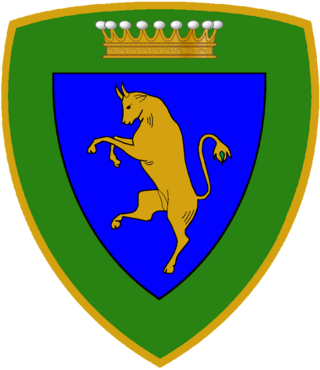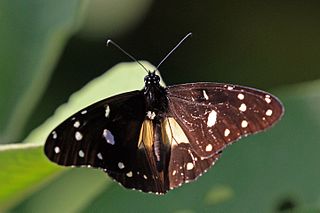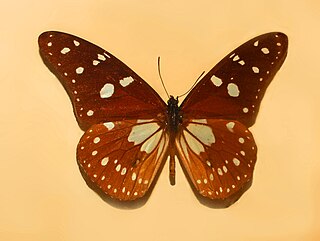
Apocynaceae is a family of flowering plants that includes trees, shrubs, herbs, stem succulents, and vines, commonly known as the dogbane family, because some taxa were used as dog poison. Members of the family are native to the European, Asian, African, Australian, and American tropics or subtropics, with some temperate members. The former family Asclepiadaceae is considered a subfamily of Apocynaceae and contains 348 genera. A list of Apocynaceae genera may be found here.

The Alpini are the Italian Army's specialist mountain infantry. Part of the army's infantry corps, the speciality distinguished itself in combat during World War I and World War II. Currently the active Alpini units are organized in two operational brigades, which are subordinate to the Alpine Troops Headquarters. The Alpini's name comes from their inceptive association with the Alps, the mountain range that Italy shares with France, Switzerland, Austria, and Slovenia. An individual soldier of the Alpini is called Alpino.

Nature's Valley is a holiday resort and small village on the Garden Route along the southern Cape coast of South Africa. Nature's Valley lies between the Salt River, the foothills of the Tsitsikamma Mountains, the Indian Ocean and the Groot River lagoon. Nature's Valley has a balmy climate and is surrounded by the de Vasselot Nature Reserve which is part of the Tsitsikamma Park, and in turn part of the Garden Route National Park.

The 5th Alpini Regiment is a regiment of the Italian Army's mountain infantry speciality, the Alpini, which distinguished itself in combat during World War I and World War II. The regiment is based in Sterzing and assigned to the Alpine Brigade "Julia".

The Alpine Brigade "Julia" is a light infantry brigade of the Italian Army, specializing in mountain warfare. Its core units are Alpini, an infantry corps of the Italian Army, that distinguished itself during World War I and World War II. The brigade carries on the name and traditions of the 3rd Alpine Division "Julia". The division's and brigade's name allude to the Julian Alps in the Friuli region where the division's regiments recruited their troops, and where after World War II the brigade was based. Accordingly, the brigade's coat of arms is modeled after the Friuli region's coat of arms.

The Alpine Brigade "Taurinense" is a light Infantry brigade of the Italian Army, specializing in Mountain Combat. Its core units are Alpini, the mountain infantry corps of the Italian Army, that distinguished itself in combat during World War I and World War II. The brigade's name "Taurinense" alludes to the Roman name Augusta Taurinorum for the city of Turin around which the brigade is based. Accordingly the brigade's coat of arms is modeled after Turin's coat of arms. The brigade carries on the name and traditions of the 1st Alpine Division "Taurinense".

The 5th Alpine Division "Pusteria" was a division of the Royal Italian Army during World War II, which specialized in mountain warfare. The Alpini are a mountain infantry corps of the Italian Army, that distinguished itself in combat during World War I and World War II. The division was formed in 1935 and based in the Puster Valley, which gave the division its name.

The 6th Alpine Division "Alpi Graie" was a short-lived division of the Royal Italian Army during World War II, which specialized in mountain warfare. The Alpini that formed the division are a highly decorated, elite mountain corps of the Italian Army comprising both infantry and artillery units. The divisions name Alpi Graie was chosen as most of its recruits came from the area of the Graian Alps.
Secamone cuneifolia is a species of plant in the family Asclepiadaceae. It is endemic to Socotra. Its natural habitats are subtropical or tropical dry forests and subtropical or tropical dry shrubland.

Secamone is a genus of plant in family Apocynaceae, first described as a genus in 1810. It is widespread across much of Africa, northern Australia, southern Asia, with numerous species endemic to Madagascar.
Secamone racemosa is a species of plant in the family Apocynaceae. It is found in Burundi, Cameroon, the Democratic Republic of the Congo, Equatorial Guinea, Rwanda, and Uganda. Its natural habitat is subtropical or tropical moist montane forests. It is threatened by habitat loss.
Secamone socotrana is a species of plant in the family Apocynaceae. It is endemic to the Socotra Islands in the Republic of Yemen. Its natural habitats are subtropical or tropical dry forests and subtropical or tropical dry shrubland.

The 3rd Alpine Division "Julia" was a division of the Royal Italian Army during World War II, which specialized in mountain warfare. The Alpini that formed the divisions are a highly decorated, elite mountain corps of the Italian Army comprising both infantry and artillery units. Today the traditions and name of the 3rd Alpine Division "Julia" are carried on by the Alpine Brigade "Julia".

The Comando Truppe Alpine or COMTA commands the Mountain Troops of the Italian Army, called Alpini and various support and training units. It is the successor to the 4º Corpo d'Armata Alpino of the Cold War. The Alpini are light Infantry units specializing in Mountain Combat. The subordinate units of the COMTA distinguished themselves during combat in World War I and World War II.

The Cappello Alpino is the most distinctive feature of the Italian Army's Alpini troops' uniform. The Alpini are light Infantry troops, specializing in mountain combat. Initially, the Cappello was only issued to the Alpini, but soon the Cappello was adopted by the Alpini Corps' support units like Artillery, signals, and engineers. Today the Cappello is issued to members of 15 Army regiments, 3 battalions and various high commands. Thanks to the black raven feather, which is carried on each Alpini soldier's Cappello, the Alpinis are known as Le Penne Nere in Italy. A nickname the Alpini quickly adopted for themselves.
The 223rd Coastal Division was an infantry division of the Royal Italian Army during World War II. Royal Italian Army coastal divisions were second line divisions formed with reservists and equipped with second rate materiel. They were often commanded by officers called out of retirement.

Amauris niavius, the friar, is a butterfly of the family Nymphalidae. It is found in the forests of tropical Africa.

Amauris echeria, the chief, is a butterfly of the family Nymphalidae. It is found in southern Africa.

Tirumala formosa, the forest monarch or beautiful tiger, is a butterfly of the family Nymphalidae.

Secamone elliptica, also known as corky milk vine, cork vine and secamone, is a species of vines or lianas, of the plant family Apocynaceae. The range extends from southern China through much of Southeast Asia to Northern Australia, from The Kimberley, across The Top End and the East coast from Cape York to northern New South Wales. The natural habitat is monsoon forest, littoral rainforest and occasionally in more open forest types.

















